Hobby Decal | ST32004 Bf 109 Stencils
Reviewed by Rato Marczak
Following our previous reviews of Hobby Decal products (1/24 and 1/32 P-51 Mustang stencils, 1/32 A-10 Warthog stencils, and 1/32 P-47 Thunderbolt stencils), let us now show you some Luftwaffe stuff in 1/32. Just like many of you, I´m a big fan of dry transfers. Unfortunately, Verlinden has discountinued their (very small) line of dry transfers long ago, and a couple of years ago, Archer Fine Transfers become dedicated almost exclusively to armor products. Since then, we are depending on DecaDry, LetraSet for serial numbers and such. No more...
I won´t repeat Brad Hagen´s words of the advantages and disadvantages of using dry transfers. You can refer the other reviews (see above). Product ST32004 comes in three sheets, according to the number of printing colors. The quality of the printing is outstanding, and the register is almost spot on, with only marginal deviations that can be easily ignored. The Germans were (and still are) very exquisite in their engineering and documentation. This applies to virtually every Luftwaffe aircraft stencil plan, even during the final months of the war. This set captures virtually every stencil applied to the Bf-109F and later versions. I´m sure most of them can be used in earlier versions too, but it is up to you to check it out. Since dry transfers are generally an expensive product (in comparison to water slide decals), Hobby Decal has chosen to not include the placement instructions. Instead, you have to download the necessary files from their Internet page. I guess this reduced considerably the final price. Interestingly, Hobby Decal product numbers indicate the current version of the set, showing that they care about possible future corrections.
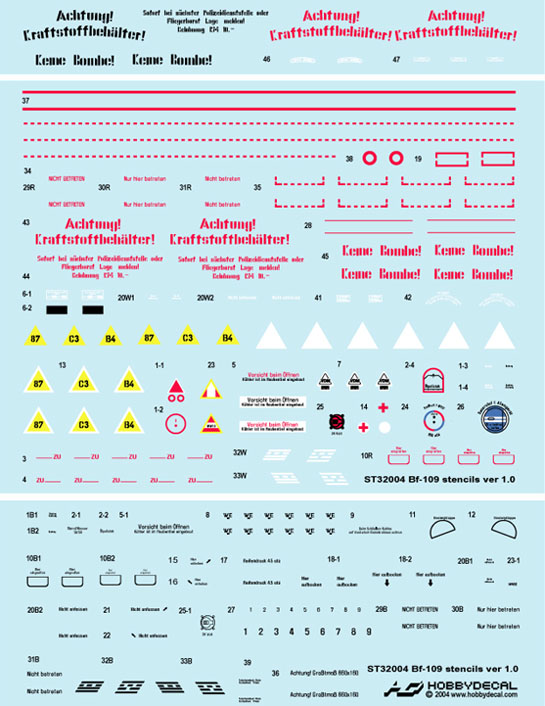
All three sheets together. The sheets are separated according to the number of colors during the printing process (image courtesy: Hobby Decal).
It is important to mention that every single item is readable using a magnifying glass. Some items are duplicated, but most of them are not, so take your time during the application. It is also interesting to note that dry transfers are enabling the accomplishment of some jobs which were impossible directly with water slide decals. An example of this is the limit diving angle warning line painted on the canopy side windows (transfer #28). This was almost impossible with decals, but is a simple task with dry transfers.
I included a reduced version of the manuals below to allow a better appreciation the amount of work put on this set.
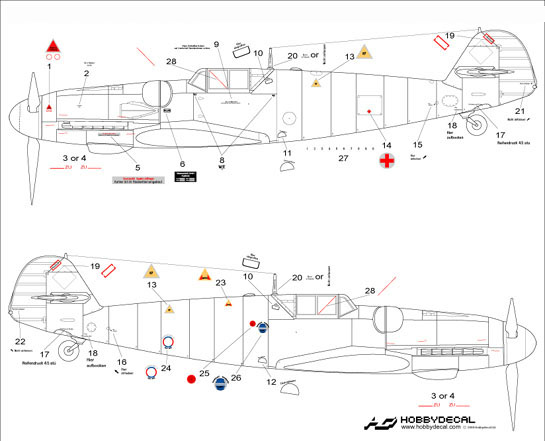
Page 1 of the placement instructions.(image courtesy: Hobby Decal).
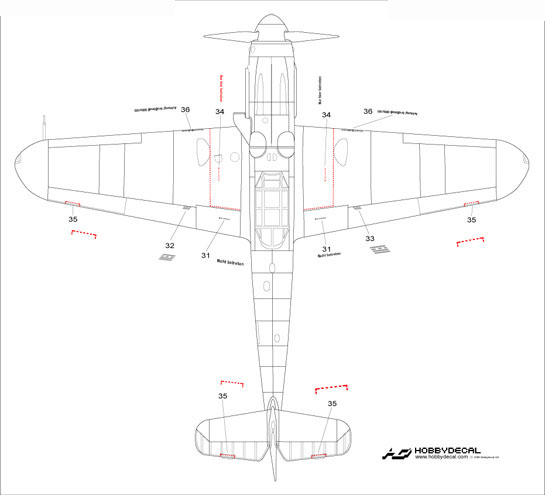
Page 2 of the placement instructions.(image courtesy: Hobby Decal).
The other good news are the walk-on dashed lines, as well as the rudder and trim tabs lines. These items are very susceptible to silvering, and very fragile in conventional decals (if included). Moreover, Hobby Decal didn´t forget the propeller blade logos (in two versions).
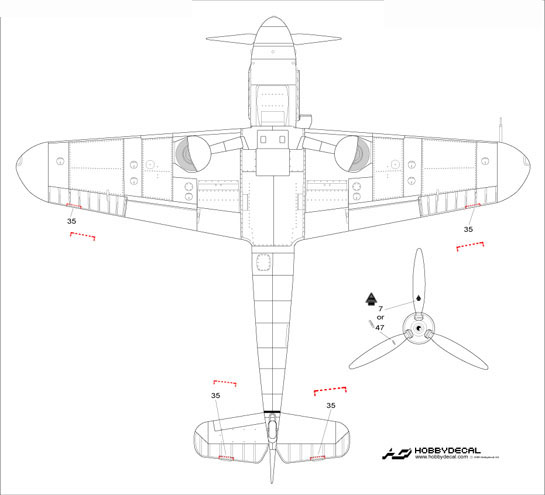
Page 3 of the placement instructions.(image courtesy: Hobby Decal).
The picture below shows the official stencil map for the Bf-109. As you can see, Hobby Decal instructions are very close, eh?...
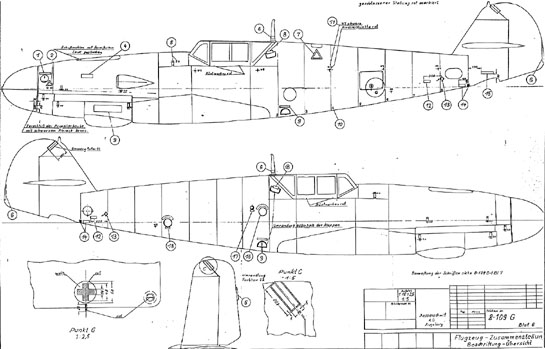
The factory stencil map of the Bf 109F (courtesy: Lynn Ritger´s 109 Lair).
Given the quality of the printing, I dared to check the accuracy of some items. The figures below show a comparison of some items from this sheet against their original factory blueprints. I found some overthick lines, but this is understandable as a limitation of the printing process. Everything else is very accurate (I confess that I have not checked all the colors) in shape and dimensions. The only exception is the 24 V battery electric connection (item #25), whose cap is inverted according to the factory drawings. In some cases, you have more than one option to choose from (all black, colored, different types of text justification, etc.), so check the references about your bird.
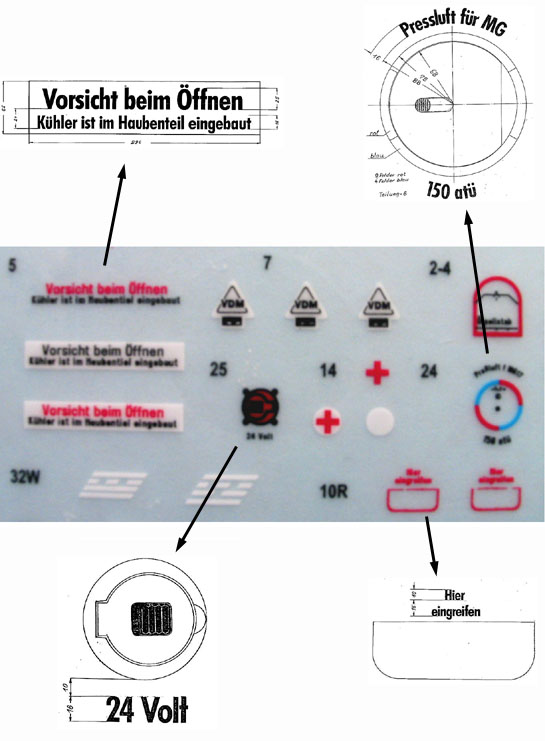
A zoom on smaller details and their factory drawings counterparts.
Even the antennae stencils are included. This is one situation where you have to apply the dry transfer on the part before cementing it to the model, so it is worth to study a bit the instructions before going too far with the assembly.
If you pay attention, you will note a row of black numbers (in two sizes) applied at factory to identify each of the fuselage sections. If you want to count rivets, the style of the numbers are slightly different than the official blueprints. Anyway, I doubt you will care that much. In addition, I bet field applied camouflage would hide them in many cases. At least I had a hard time trying to find them in WWII photos...
The fuel/oil/coolant triangles are offered with the option of applying them complete or the white background triangle first, and then the yellow one on top of it. The last option should be used in case you don´t agree with eventual out of register problems. I didn´t find photos showing them without the white outline.
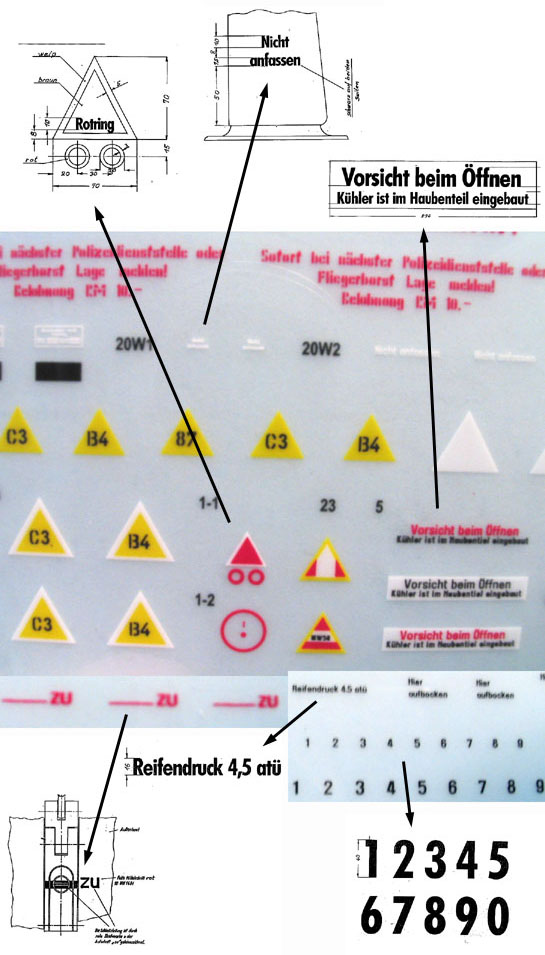
Another zoom on smaller details and their factory drawings counterparts.
How they go on a finished model, you ask? Here are some pics of this sheet in action. I´ve measured some recessed details molded on the fuselage of the Revell-Monogram Bf 109G-4, and compared with the corresponding dry-transfers to be applied on... they match wonderfully.
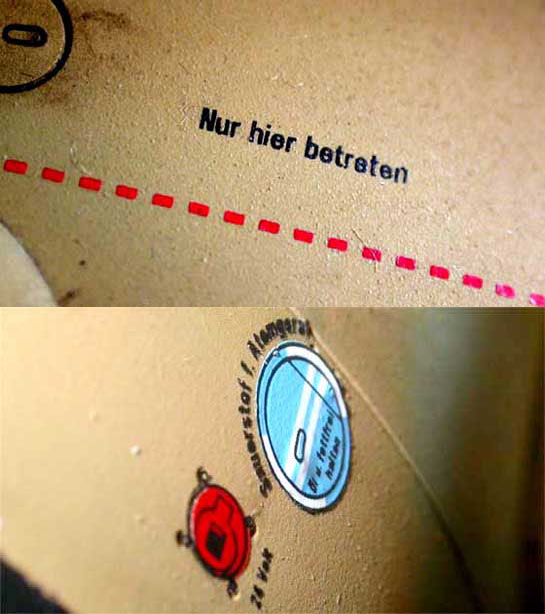
Dry transfers in action - take one. (image courtesy: Hobby Decal).
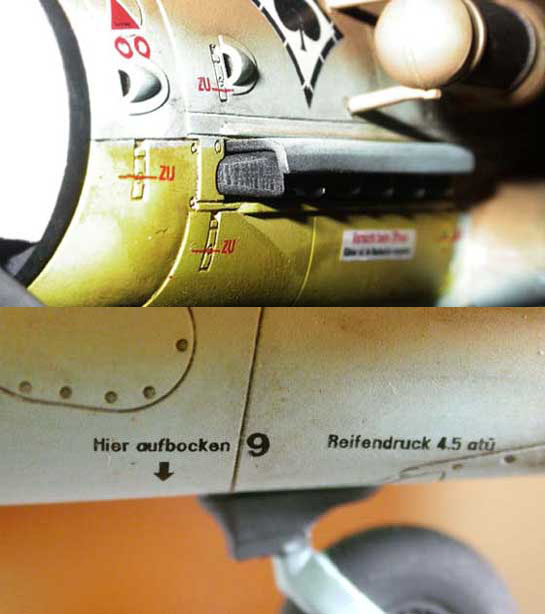
Dry transfers in action - take two. (image courtesy: Hobby Decal).
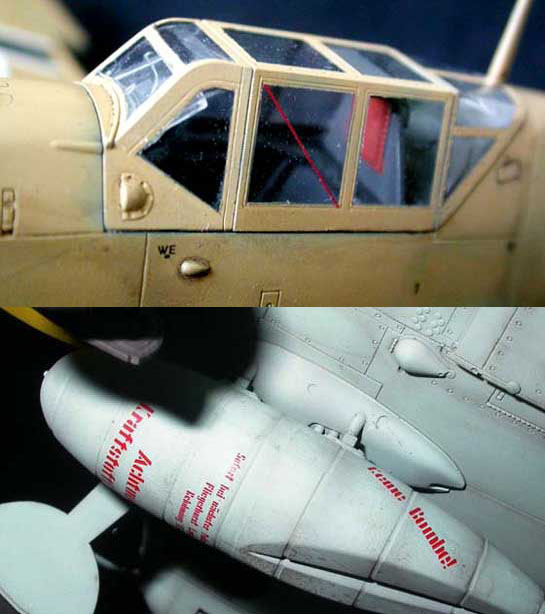
Dry transfers in action - take three (image courtesy: Hobby Decal).
Are they worth it? Well, every cent, in our opinion. It is very tough to find faults in a well applied water slide decal after a couple of coats of varnish. And surely they are more forgiving. However, as the pictures above show, dry transfers have their place in modeling.
Additionally, you can apply dry transfers directly over flat paints, and they won´t detract from the final appearance of the model, as they are flat too. They also conform to the surface details without stinking setting solutions that can stain your paint job after some years (I talk by experience). Not to mention the subjects in natural metal finishes, an old nemesis for clear films, you know. Just take care with hot thinners applied over them, because they may melt the transfers.
If you are not convinced, you can always apply the dry transfers on a piece of clear decal film and use them as an ordinary decal.
As a final note, Hobby Decal is sending a gift for the first orders: a burnishing tool. I´m convinced it is, in fact, a knitting needle, what is a good tip by itself. They are great for the smaller transfers, but I recommend a larger tool for the others.
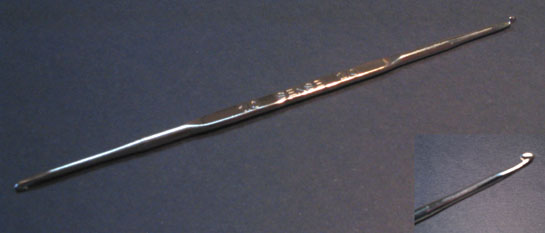
Burnishing tool or knitting needle?
Hobby Decal line of dry transfers are not cheap products. You pay about the price of a large water slide decal sheet for something that will cover much less area, one may wonder. But these sets are taking care of those tiny details that are always bugging us: stencils, and in a way which is, in my opinion, unbeatable. I believe a stunning model is made out of a sum of small details greatly accomplished, and that´s why I always enjoyed dry transfers. Hopefully, other manufacturers will (re-)adopt the idea in a near future.
Review sample compliments of Hobby Decal. Thank you for your support.
© Rato Marczak 2004
This review was published on Saturday, July 02 2011; Last modified on Wednesday, May 18 2016
